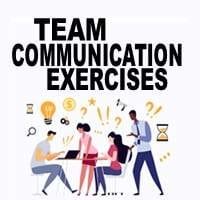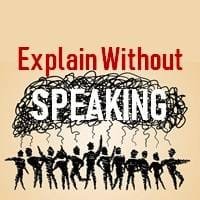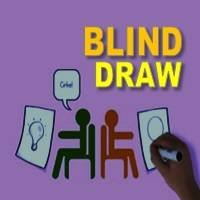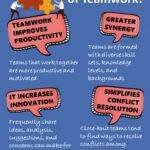
Fun Team Communication Exercises
Team communication exercises are a type of team building initiative and are similar to relationship strengthening activities.
This exercises are activities and exercises that improve teammates’ ability to exchange information. The purpose of these activities is to show the importance of clear communication to strengthen employees’ verbal and nonverbal conversation skills.
Explain without speaking

Explain without speaking is a great activity both for small and large groups and underlines the importance of good communication. Divide participants into groups of 4 or more people. There can be up to 10 people per group.
For smaller groups, it’s best to have everyone play together.
To begin, the groups are set in a queue, each person with their back to the person behind them so that no one is face to face. One player will lead this activity and won’t participate.
The leader comes up with a phrase, it can be work-related, or something fun! The leader then whispers this phrase to the first person in the queue of each group, and with this, the game start.
When the leader says ‘Go’, the first person in each queue taps the next person on the shoulder, and when they turn around, he/she tries to explain, without speaking, the phrase that the leader gave them.
After 30 seconds, the leader shouts “Change!” and the second person turns around, taps the next person on the shoulder, and the activity repeats as they try to explain whatever they understood from the first person. Be sure that players are not speaking throughout the entire activity.
The game continues until the last person in each queue has participated. Each player has 30 seconds to try to understand the expression and 30 seconds to pass on the information.
Once the game is complete, the last person verbalizes in front of the whole group what they think the phrase is. The results are usually very funny!
Blind Draw

In blind draw activity, the team has to instruct their “artist” to draw an item. They have to describe their chosen item without revealing what it is and they are not able to see what the “artist” is drawing.
Each team appoints a member to be the “artist” and the “artist” is then separated from the rest of the group. The remaining members select an item from those provided by the facilitator and will instruct the “artist” to draw it without saying what the item is.
There is a time limit of 3 minutes for the drawing to be completed. Each flipchart is positioned to face away from the group so that they cannot see what the “artist” is drawing.
Get each team to appoint their “artist” who is then separated from the group. Each team selects an item from those provided.
At the end of the activity, all the images are revealed. The team whose drawing is closest to the actual item they chose wins the game.
This activity is great for promoting communication skills. While it seems like an easy task, the team’s one-way communication with their “artist” must be accurate.
It may be useful to run this activity in two rounds; after the first round, the team will realize how important it is to be detailed in their instructions.
Challenge the teams to do better in the second round!
Writing a Book

Writing a Book is a game that encourages creativity, collaboration, and memory. It also gives you something concrete to look at in the future to see where your team has been and how far it has come.
This team-building exercise is not done all at once, but over time. Make a large, blank journal or scrapbook available in the break room or other common areas.
Leave pens, markers, tape, and other items that your team can use to write and draw on the book. Encourage them to write quotes from what they are reading or from team members, to write about a fun event that happened at work, temporary tape or glue, or anything that helps record the culture of the team.
The book can have instructions on each page, ask questions, or suggest things to write or draw. Or you can have the guidelines printed and displayed alongside the book (i.e. no swearing, nothing offensive, no complaints, no scribbling in others’ work, etc.).
When the book is full, put it on the shelf and get a new one. The purpose of this team exercise is to create a living story about your group.
The Trust Walk

Trust Walk is a team building activity that helps people practice trusting each other and develop effective communication. One person must guide their blindfolded partner using verbal instructions around the obstacles.
This activity is an active team building activity that requires a large amount of space. An outdoor setting with a few obstacles, but nothing too dangerous.
Whoever facilitates this exercise should form pairs, it is important that the participants of each pair know each other as little as possible. Materials needed include blindfolds and any props that can be used as minor obstacles.
The game involves leadership and confidence building, as blindfolded participants must trust their interlocutor. The blindfolded person must follow the instructions given to avoid colliding with obstacles.
Large fields or forests can be good places to develop the activity. Minor obstacles (trees, branches, small hills) are fine, but don’t play this game in a dangerous environment.
Once you’ve found a large, safe area, you can place additional obstacles if you like (cardboard boxes, balloons, etc.).
Once the person to guide is ready and blindfolded, ask them to turn slowly several times so that you are not sure which way to go. From this moment on, the guide must not touch the partner at all, he can only give verbal orders.
Remember that the guide is solely responsible for the safety of your companion. He or she must do everything possible to get their partner away from the obstacles and complete the course.


